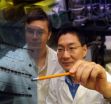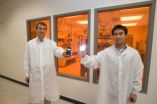(Press-News.org) Pioneering new research by archaeologists at the University of York suggests that Neanderthals belied their primitive reputation and had a deep seated sense of compassion.
A team from the University's Department of Archaeology took on the 'unique challenge' of charting the development of compassion in early humans.
The researchers examined archaeological evidence for the way emotions began to emerge in our ancestors six million years ago and then developed from earliest times to more recent humans such as Neanderthals and modern people like ourselves. The research by Dr Penny Spikins, Andy Needham and Holly Rutherford is published in the journal Time and Mind.
The archaeologists studied archaeological evidence and used this to propose a four stage model for the development of human compassion. It begins six million years ago when the common ancestor of humans and chimpanzees experienced the first awakenings of an empathy for others and motivation to 'help' them, perhaps with a gesture of comfort or moving a branch to allow them to pass.
The second stage from 1.8 million years ago sees compassion in Homo erectus beginning to be regulated as an emotion integrated with rational thought. Care of sick individuals represented an extensive compassionate investment while the emergence of special treatment of the dead suggested grief at the loss of a loved one and a desire to soothe others feelings.
In Europe between around 500,000 and 40,000 years ago, early humans such as Homo heidelbergensis and Neanderthals developed deep-seated commitments to the welfare of others illustrated by a long adolescence and a dependence on hunting together. There is also archaeological evidence of the routine care of the injured or infirm over extended periods. These include the remains of a child with a congenital brain abnormality who was not abandoned but lived until five or six years old and those of a Neanderthal with a withered arm, deformed feet and blindness in one eye who must have been cared for, perhaps for as long as twenty years..
In modern humans starting 120,000 years ago, compassion was extended to strangers, animals, objects and abstract concepts.
Dr Penny Spikins, who led the research, said that new research developments, such as neuro-imaging, have enabled archaeologists to attempt a scientific explanation of what were once intangible feelings of ancient humans. She added that this research was only the first step in a much needed prehistoric archaeology of compassion.
"Compassion is perhaps the most fundamental human emotion. It binds us together and can inspire us but it is also fragile and elusive. This apparent fragility makes addressing the evidence for the development of compassion in our most ancient ancestors a unique challenge, yet the archaeological record has an important story to tell about the prehistory of compassion," she said.
"We have traditionally paid a lot of attention to how early humans thought about each other, but it may well be time to pay rather more attention to whether or not they 'cared'."
INFORMATION:
Dr Spikins will give a free public lecture about the research at the University of York on Tuesday 19 October. Neanderthals in love: What can archaeology tell us about the feelings of ancient humans takes place in room P/L001Department of Physics.
The researchers are publishing the study as a book The Prehistory of Compassion that is available to purchase online. All proceeds go to the charity World Vision.
www.blurb.com/books/1628917
www.blurb.com/bookstore/detail/1628917
Neanderthals had feelings too, say University of York researchers
2010-10-06
ELSE PRESS RELEASES FROM THIS DATE:
Umbilical cord blood not suitable for assessing allergy risk
2010-10-06
Allergies occur when the defence mechanisms of the immune system malfunction and misread normal substances entering the body as invading pathogens. Antibodies are part of our biochemical arsenal for combating viruses, bacteria, parasites and other alien substances, but during an allergic reaction the antibody, known as IgE, is directed against usually harmless substances such as grass pollen, nuts, pets or eggs. Asthma and allergies are chronic diseases that reduce quality of life and pose an economic burden on society. New parents have therefore previously been asked if ...
Light drinking during pregnancy does not harm child's behavioral or intellectual development
2010-10-06
Light drinking during pregnancy does not harm a young child's behavioural or intellectual development, reveals research published online in the Journal of Epidemiology and Community Health.
A previous study of 3 year olds drew similar conclusions, but the authors wanted to rule out possible delayed "sleeper" effects in older children.
They used data from the Millennium Cohort Study - a large study tracking the long term health of children born in the UK - drawing on a representative sample of 11,513 children born between September 2000 and January 2002.
Participants' ...
Overhaul 'made-to-order' drugs, which cost NHS millions, urges DTB
2010-10-06
The provision of made-to-order drugs ("specials") in primary care is expensive, often unnecessary, and associated with legal pitfalls, says the Drug and Therapeutics Bulletin (DTB).
It calls for a major overhaul of the practice, in a review of the evidence in this month's issue.
Bespoke drugs or "specials" are medicines made specifically to meet the needs of individual patients, so may be prepared in formulations and strengths which differ from those of standard licensed medicines.
They might be prescribed, for example, when a patient can't or won't swallow tablets ...
Persistently noisy workplace more than doubles heart disease risk
2010-10-06
A persistently noisy workplace more than doubles an employee's risk of serious heart disease, suggests research published online in Occupational and Environmental Medicine.
Young male smokers seemed to be particularly at risk, the findings showed.
The researchers base their findings on a nationally representative sample of more than 6,000 employees, aged from 20 upwards, who had been part of the US National Health and Nutrition Examination Survey (NHANES) between 1999 and 2004.
This involved detailed household interviews, to include lifestyle and occupational health, ...
Mice with human body's defenses
2010-10-06
Therapeutic antibodies can be an efficient alternative when common drugs do not work anymore. However, antibodies obtained from blood of animals such as mice could not be used: The human immune system recognizes them as foreign and rejects them. In an international cooperation, scientists from the Helmholtz Centre for Infection Research (HZI) in Braunschweig, Germany have now succeeded in developing a promising approach to solve this problem; with the help of human stem cells they generated mice with a human immune system, which were then vaccinated to produce human monoclonal ...
Powerful free radical causes lung damage from oxygen therapy
2010-10-06
AUGUSTA, Ga. – The most toxic free radical appears responsible for much of the lung damage that can result from oxygen therapy in the critically ill or injured, Medical College of Georgia researchers report.
Within just a few days, ventilators and oxygen chambers used to significantly increase oxygen levels can also dramatically increase levels of peroxynitrite, an oxidant powerful enough to break down DNA and cause proteins to malfunction, said Dr. Yunchao Su, pharmacologist in the MCG Schools of Medicine and Graduate Studies.
Oxygen toxicity is the most severe side ...
Is your job making you fat?
2010-10-06
Montreal, October 05, 2010 – Working nine-to-five may be the way to make a living, but it may be padding more than the wallet. According to a new study from the Université de Montréal, office-workers have become less active over the last three decades and this decreased activity may partly explain the rise in obesity. Their findings, published in the early online edition of Preventive Medicine, may have health implications for the millions of people toiling behind their desks.
"People eat better and exercise more today than they did in the 1970's, yet obesity rates ...
Breakthrough e-display means electronics with high speed, high readability and low power usage
2010-10-06
Today's Oct. 4 issue of the high-impact journal, Applied Physics Letters, contains a new electrofluidics design from the University of Cincinnati and start-up company Gamma Dynamics that promises to dramatically reshape the image capabilities of electronic devices.
This patent-pending electrofluidics breakthrough by the Novel Devices Laboratory at the University of Cincinnati and partner companies Gamma Dynamics, Dupont and Sun Chemical follows about seven years of work. According to lead researcher Jason Heikenfeld, UC associate professor of electrical and computer engineering ...
Fish oil linked to increased risk of colon cancer in mice
2010-10-06
EAST LANSING, Mich. — Fish oil – long encouraged by doctors as a supplement to support heart and joint health, among other benefits – induced severe colitis and colon cancer in mice in research led by Michigan State University and published this month in the journal Cancer Research.
Jenifer Fenton, a food science and human nutrition researcher at MSU, led the research that supports establishing a dose limit for docosahexaenoic acid (DHA), one of the omega-3 fatty acids present in fish oil, particularly in people suffering from chronic conditions such as inflammatory bowel ...
'Paradigm shift' in how physicians treat peripheral artery disease
2010-10-06
A balloon angioplasty device that sucks up dangerous plaque debris could trigger a "paradigm shift" in how physicians treat peripheral artery disease, researchers write in the current issue of Endovascular Today.
"We will see a shift in how we treat lesions," write Dr. Robert Dieter of Loyola University Health System and Dr. Aravinda Nanjundappa of West Virginia University.
In two clinical trials totaling 123 patients, the device had a success rate of 97 percent to 99 percent and consistently outperformed filter devices typically used to capture debris particles, Dieter ...

